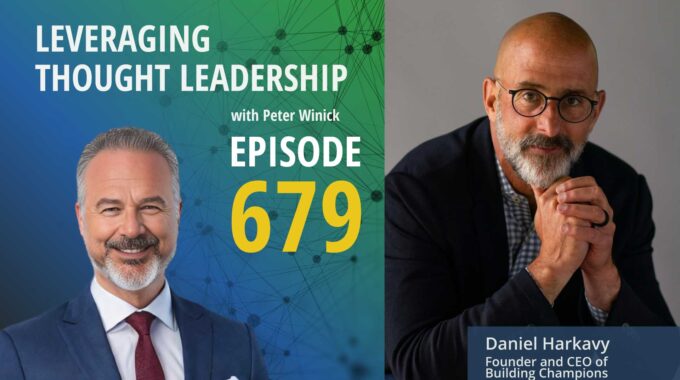A roadmap for leaders who want to multiply their impact — not their workload. This…
Why Connection, Not Command, is the Real Engine of High Performance | Michael Abrashoff

From Low Morale to High Performance: Leadership That Works
This episode explores how effective leadership transforms culture through connection, not control. It highlights the power of listening, intrinsic motivation, and small daily improvements to drive performance—even in rigid or high-stakes environments. You’ll learn why respect, accountability, and personal engagement consistently outperform command-and-control tactics in any organization.
What if the worst-performing team you’ve ever seen could become the best—without changing a single person?
Today, Peter Winick sits down with Michael Abrashoff, former U.S. Navy captain and author of the mega-bestseller “It’s Your Ship: How Great Leaders Inspire Ownership From The Keel Up”. Michael shares the extraordinary turnaround story of the USS Benfold—once one of the lowest-ranked ships in the fleet—and how he transformed its culture by focusing on something rare in the military: personal connection.
He didn’t ask for a new crew. He didn’t get a bigger budget. What he did instead? Interviewed all 310 sailors, created personal index cards with their goals, strengths, and passions—and committed to leadership by listening.
Peter and Michael dig into the difference between authority and influence, and why so many brilliant technical leaders fail when they’re promoted. Michael also explains how he helped shift a culture of compliance into a culture of ownership—one small improvement at a time.
You’ll hear how his military insights apply directly to boardrooms, sales teams, pharma execs, and even Boilermakers. And why the top five reasons people leave organizations haven’t changed in 25 years!
This conversation is a masterclass in practical leadership. Because whether you’re running a ship or a startup, the most powerful tool you have isn’t command—it’s connection.
Three Key Takeaways
Connection Drives Performance – Leaders who invest time in personally understanding their team members build trust, loyalty, and higher performance without needing more resources or authority.
Small Improvements Compound – A mindset of daily 1% improvements can lead to transformational change, even within rigid systems like the military.
Respect and Listening Are Retention Tools – People don’t leave organizations for money alone; they leave when they don’t feel valued, heard, or developed—making culture a strategic priority.
If you found value in our conversation on leadership transformation and culture change, you’ll want to check out our episode with Christian “Boo” Boucousis, a former Royal Australian Air Force fighter pilot turned CEO and thought leader. Boo shares how he applied military precision and adaptability to navigate the challenges of transitioning Afterburner, a global consultancy of elite military professionals, into the virtual realm during the pandemic. His insights on converting information into wisdom, engaging audiences across modalities, and leading with agility offer a compelling complement to our discussion on building high-performing teams through connection and ownership. Tune in to discover how discipline, curiosity, and emotional resonance can elevate your thought leadership to new heights.
Transcript
Peter Winick And welcome, welcome, this is Peter Winick. I’m the founder and CEO at Thought Leadership Leverage and you’re joining us on the podcast, which is Leveraging Thought Leadership. Today, my guest, I’m really, really happy to have my guest today. Not that I’m not on other days, but extra happy today, Mike Abrashoff. And I’m gonna actually read the full bio, which I typically don’t do. So Mike is at the center of one of the most celebrated success stories in turnaround leadership. At the age of 36, the Navy selected Mike. To become commander of the USS Benfold at the time, the most junior commanding officer in the Pacific fleet. The immediate challenges that faced him were staggering, exceptionally low morale with the unacceptably high turnover. Few thought the ship could improve in many ways. The USS Ben Fold was actually an extreme example of the same problems facing many organizations today. He recounted the leadership lessons from the turnaround in his book, It’s Your Ship, which was a New York Times bestseller. Which has sold over 800,000 copies, which if you know anything about the book business, that’s kind of like Star Wars, if it was a movie. So anyway, welcome aboard, Mike. See what I did there. You like that.
Mike Abrashoff Thanks, Peter. But I’ve now sold over 1.5 million copies of it’s your ship.
Peter Winick Ah, you know, update the bot. 1.5. Holy cow. You know, so just the average business book sells 2,500 copies. So this is like, I get that very, very cool. So. You know I’ve worked with, and I’ve spoke with thought leaders that have come from various backgrounds, including the military. So tell me about sort of that, you don’t wake up one day and say today, I’m going to be a thought leader, right? How did this happen? The turnaround story and then decided to write a book and speaking and like Tell us about that journey.
Mike Abrashoff It did happen overnight. Um, okay. I took command of one of the, not the worst ship, but in the bottom five in the Pacific fleet. And when my predecessor was leaving the ship for the final time with his family and his wife and, uh, his kids, and as his departure was announced on the public address system, my new crew stood and cheered at the fact that he was leaving and in that moment, it hit me. Uh, as I came up through the ranks, I wonder how many of my sailors secretly cheered whenever I got transferred. And I didn’t know the answer to the question. So that caused me to become more self-aware and to view myself through the eyes of my Sailors and try to figure out how to connect with them on a level that would get them to feel like they have just as much at stake in the success as I do. And so that’s what caused my journey. And that caused me to interview every sailor on the ship individually, all 310 of them.
Peter Winick So stay for a minute. I mean, you gloss over the interviewing of the 310. Like, of course you would do that. And it seems like an obvious thing to do, but how many leaders come into a new role, a new position, a knew whatever, and they spend their time isolated with their top five or their, you know, where your jokes are funny or in everything you say is smart or whatever, but you, you don’t literally spend, how much time did that take to talk to 310 people?
Mike Abrashoff I bet you I would spend two or two, three hours a day, five days a week for the first four months.
Peter Winick I mean, that’s a commitment. That’s not a minor, hey, we were just town hall and let me tell you my vision and then I’ll see, I’ll never see you again.
Mike Abrashoff And I had a photo taken of every sailor. I had an index card. I would staple that photo to the index card and after the interview, I would write down what I learned, what their goals were while they were in the Navy. What their goals in life, what they were most proud of in their lives, uh, that nobody worked knows anything about. And then whenever I would have a free moment, I would flip through my 310 index cards. And that’s how I learned the name of every sailor, their face, their job. What their goals were so that when I see them in the passageway, I can chat them up and ask them how things are going. And you know what, if your people think you care about them, they’re going to follow you into battle and it’s not rock science, it’s just executing on simple things better than anybody.
Peter Winick But it’s also interesting what you say is there are some people that have the gift, you know, and Clinton was known for this as, as an example of they could just connect with people and light them up or they would remember someone they met 20 years ago and ask how their kid was or whatever, you had to put the effort in like 310 cards. You knew them personally, professionally, hobbies, passions, whatever. That’s a, that’s an ongoing commitment to connection.
Mike Abrashoff Remember them to this day. Uh, I can do math or physics. Um, I enjoyed physics so much at the Naval Academy. I had to take it twice, but I can remember names, faces, people’s goals, and to figure out how to connect with them, it’s just this, a gift I may have. I don’t know. That’s great.
Peter Winick What made this ship so terrible before you got there? Because I would imagine it’s not the hardware. Wasn’t like this was the oldest or the most decrepit or the whatever.
Mike Abrashoff It was one of our newest ships packed with the latest technology. It should have been near the top in performance. I want to bad mouth my predecessor. He’s a brilliant man and one of the most brilliant nuclear trained engineers, the Navy has ever produced. And instead of becoming captain of the ship, he became the super chief engineer, micromanage the engineers to the death and, uh, as a result, Benfold became the first new construction ship. In the history of the Navy to flunk their first engineering certification because the engineers just folded their arms and say, you do it. And so everything fell apart and the rest fell apart as well.
Peter Winick This, so stay there for a minute. So he was clearly technically off the charts, right? In terms of the, the, the engineering savvy, the all that sort of stuff. Top point zero 1%. Right. And I’ve seen this in other spaces, whether it’s, you know, the top surgeon becomes the CEO of the hospital and implodes or the top scientist or the top chemist at a pharma company or whatever. And part of it you think about and go, well, that doesn’t make sense. And the other part, you go, it makes perfect sense, right. Because now all of a sudden you’re thrown into this role where, yeah, the technical stuff is important, but it’s about the people. And if you never develop that, you’re not going to develop that overnight.
Mike Abrashoff And I’ve worked with a pharma company in the sales department where they promoted the top salesperson to be head of sales and no deal could be done unless he was involved in it. And so he got down in the micro, the nitty gritty, instead of looking at the big picture and focusing on how to position everybody to win, he had to be involved in every detail and everything.
Peter Winick And again, that makes perfect sense. Cause the greatest salespeople know how to get things across the finish line themselves, right? If you’re leading salespeople, your job is to make those other 50, a hundred thousand, whatever number of salespeople as best as they can be as performers and get yourself out of the way, not in the middle of every transaction.
Mike Abrashoff And I used to do what if scenarios figure out what’s the worst thing that could happen to us and then to minimize risk, put training programs in place or processes in place so that we don’t get hit by a missile or that we don’t hit a mine or don’t run a gram. And so that’s to me, that’s what leaders should be doing is having the time in the day to focus on what ifs scenarios and then putting protective measures in place. So it doesn’t happen to you, but also so that you can capitalize on it, if it does come your way, they answer your question. I couldn’t change anybody out when I took command, it was the same crew that was there preview. They just took ownership in the interviews. I’d ask them, uh, what do you like most about this ship? What do you, like least? What would you change if you were the captain? And I said, I don’t care what your age is and I don’t hear what your rank is. I don’t care how long you’ve been here. You can come to work every day and challenge every aspect of our operation. And if you have an idea how to improve a process, just 1%, raise your hand and tell me about it. And so we weren’t about radical change. I mean, it’s the Navy, I’ve got regulations I have to live within. It was improving 1% a day and having that mindset that we were going to execute better than anybody else. And that’s when the crew took pride in themselves, took pride in their work, took accountability. Collaborated across the five departments. And that’s what made us the, in essence, that.
Peter Winick That’s the DNA, that’s culture, right?
Peter Winick If you’re enjoying this episode of Leveraging Thought Leadership, please make sure to subscribe. If you’d like to help spread the word about our podcast, please leave a five-star review at ratethispodcast.com forward slash LTL and share it with your friends. We’re available on Apple Podcasts and on all major listening apps, as well as at thoughtleadershipleverage.com, forward slash podcast.
Peter Winick I wanna talk a little bit, again, I’ve worked with fighter pilots and helicopter pilots and cybersecurity generals and all that sort of stuff. And sometimes when they go your route, meaning as a thought leader, as a keynote speaker and such into the corporate world, people like the stories, the drama of the stories the combat, the bravery, the courage it takes to be a Navy SEAL or green brain, all that sorta stuff. But you’ve done a really beautiful job of transitioning. And making it so relevant to whatever that be a farm up company or sales or a technology company or whatever, because people are people are people, right? Like it’s not about the, you know, this only applies in high stakes, life and death situations.
Mike Abrashoff What has made me relevant to corporate audiences is I didn’t get to choose our missions and I had to choose the people I work with and I couldn’t go back and ask for more money to get the job done. So how do you drive performance when there’s all these variables that you can’t influence? Well, the number one thing you can influence is yourself and having the self-awareness to understand how you’re showing up, but also to create that culture by which people want to be a part. And want to come to work every day passionate and motivated and wanting to deliver excellence.
Peter Winick Well, and it’s interesting that you say that, because the research shows us that most people most of the time are motivated more by the intrinsic, yet most organizations are still rewarding based on the extrinsic. And when you think about the extremes of that, if you think it on a barbell, nobody can get more wealthy than a techie in the valley, right? Yet, and that’s extrinsic, right, like, wow, I’m a 28-year-old coder and I’m superstar and I can make 100 million bucks, But the cultures there tend to be toxic Right. When you think about it. So it’s interesting that all these constraints that you say you have, well, I, you know, I can’t pay them more and I can do this and I can’t do that and I do that. It limits the variables to what you can control to the one that makes sense, which is largely intrinsic, right? Treat someone with respect. Does that cost any money? Get to know somebody does that.
Mike Abrashoff Side, I don’t know if you follow NFL, but Josh out in the star quarterback of the Buffalo Bills just left like $8 million on the table and his contract, because he said, I want you to use it to bring in other, other stars. He said, like, I’ve got a house, I got a car. I’m set. I don’t t need an extra 8 million. It’s not going to affect the quality of my life. So anyway, that that’s an example of a person looking out for the good of the organization. And leaving some on the table to bring in greater talent to help them get to the next level of performance.
Peter Winick Well, that’s a dream example of self-sacrifice. Is the tools that you had to turn the ship around, right? Like, so if I, if I take that parallel and say, Oh, let’s pick a company that’s, you know, not doing great, like whatever, and we’re going to bring in the turnaround CEO. Well, they’re going figure out who the best people are and how do we compensate them more. And if you get us to this sales goal and this, you’ll make another whatever. It usually doesn’t start with interviewing 310 people. Say, tell me about you, what would you change? What would you do differently? They literally bring in the turnaround specialists that by very definition, there’s an assumption that, well, everybody here knows nothing, right? So we’re bringing in these outsiders that know everything. And I think that’s that creates separation, not connection.
Mike Abrashoff And, uh, they bring things that worked at their past, yeah, not knowing whether it’s going to work in this particular organization and they end up breaking things that are already working instead of, you know, focusing on the things that aren’t working. But when I took command, we had an 8% retention rate and the admiral said to me, Mike, you can’t do anything about it because they’re leaving because of our low pay. Well, I did exit surveys. Why are you leaving? Pay was important. It was number five on the list of reasons why they were walking door. Number one was they didn’t feel like they were being treated with respect in the workplace. Two, they didn’t t feel like they were being listened to. Three, they feel like they were getting the training they needed to do a great job. And four, they feel like they were being groomed for increased positions of responsibility. And you remember 2022, you know, the year of the great resignation when it seems everybody was changing jobs. McKinsey comes out with a landmark study. Top five reasons why people were leaving that year. Same top five reasons that I figured out 25 years ago, just by interviewing our people and finding out.
Peter Winick You could have started a consultancy and charge companies a hundred million dollars to give them an obvious answer, right? Right. It’s just common sense. I’m not peddling. So don’t tell anybody, don’t tell anybody common sense or you’ll. The McKinsey people will not be happy with that. I want to shift a little bit to the business side of thought leadership. So you’ve been at this for how long now as a speaker, how many? 25 years. So you seen the good, the bad, the ugly, you’ve seen lots of different things as a thought leader. So let me sort of throw this at you. And feel free to punch holes in it is that there’s pieces of everyone’s thought leadership that’s evergreen, regardless of who’s in the white house. And are we in a recession or a thriving economy or what’s going on in the world? And then there are elements of your intellectual property of your thought leadership that become more relevant due to external pieces, right? So for example, early COVID probably around that 2022 great resignation time. Psychological safety. That’s all everybody talked about. Well, that wasn’t a new concept by any stretch of the imagination. Amy Edmondson came out with the book amongst others. And now what happened was we were talking about it. It became part of the vocabulary, part of what is now acceptable to embrace in the corporate world. So if you were in that space, you made the connection. So give me a sense of the pieces of your thought leadership that are true, regardless of what the weather or the temperature is and the things Get spiky, because you’ve been around long enough to see 2008 and, you know, different, different cycles in the business cycle.
Mike Abrashoff So, uh, what’s interesting is it’s not the bad companies that bring me in. The people that bring in are the good companies wanting to get to the next higher level.
Peter Winick So that’s the case, right? Those that, so if you, if you had your druthers, you’d say who should hire you and who does there, there’s, there, it’s two different lists. That’s interesting.
Mike Abrashoff You’re right in that I think my story, I’ve been told that my story is an evergreen story because at the end of the day, we’re all in the people business, whether you’re in the military, whether you’re at a bank or whatever, or Boilermaker. I’ve spoken to Boilermakers in this country.
Peter Winick cocktail that people actually make the boilers because I’ve spoken boilermaker to it as a cut it’s not the cocktail. Yeah.
Mike Abrashoff I’ve, the carpenter’s union brings me in just about every other year to speak to carpenters and, and so what I think what’s important and what, and why the story endures is as I said, the things I couldn’t influence during the great financial crisis, you know, I did just as many speeches as I did in good economic times, so I can tailor the message on resilience and how do you fight through adversity. I can talk about safety because when I took command, in addition to poor morale, poor retention, lousy culture, lousy performance, we also had a high, a high accident rate and just by getting people engaged and getting them to take ownership, they tend to apply more with the standards that we set for them. And in my last year, we came in number two for the Navy safety award.
Peter Winick It sounds like the safety outcome was almost a by-product of the other stuff. It wasn’t necessarily the primary objective is to make the ship a safer ship.
Mike Abrashoff Part of the, although what drove me every day was not my next promotion. It was never having to write the parents of any of my sailors telling them that their sons or daughters aren’t coming home because we didn’t give it our best. And ships, as you can imagine, are very dangerous places to work. And on average in a commanding officer’s two-year tour, one sailor will get killed or one sailor we’ll get seriously injured. So it’s serious business. And if you don’t have a culture that values safety. And that, that gets people to not, to look out not only for themselves, but also for your rights. Um, that’s, that how you drive safety in my opinion.
Peter Winick I love it. I love this has been great. Mike, I really appreciate your time and your effort and your energy. And thank you for your service.
Mike Abrashoff Thanks for having me.
Peter Winick To learn more about Thought Leadership Leverage, please visit our website at ThoughtLeadershipLeverage.com. To reach me directly, feel free to email me at peter at Thought Leadership leverage.com and please subscribe to Leveraging Thought Leadership on iTunes or your favorite podcast app to get your weekly episode automatically.





